 MAMA XI 245 (Kinna)
MAMA XI 245 (Kinna) 
Funerary stele for Urbana and others
- Type of monument:
- Funerary stele.
- Location:
- Karakilise (Karacaören) (Kinna): in an old cemetery half an hour to the south of the village.
- Description:
- Whitish limestone stele, broken in two. At top, round panel in roughly rectangular pediment, with four busts in relief: above, two male busts and one veiled female bust, each with right hand laid across the chest; below, small bust within arch. Lines 1-2 of inscription on lower mouldings of pediment; lines 3-15 on shaft. On shaft, inset panel with highly decorative mouldings and arched aedicula at centre; below, incised depictions of sickle, spindle and distaff, bill-hook and plough.
- Dimensions:
- Ht. c. 1.90 (upper fragment 1.15+, lower fragment 0.85+); W. 0.69 (upper moulding), 0.60-0.76 (shaft); Th. --; letters 0.020-0.030.
- Record:
- Line drawing; squeeze; AH notebook copy; photographs (1957/16=5759-60).
- Publication:
- Calder 1910: 240, no.10 (line 1 only); Calder 1910: 240, no.11 (line 2 only); (S. Mitchell, RECAM II 304-5).
- Date:
- Roman imperial period.
Αττας Δαδεως Ὀρβάνᾳ [τ]ῷ Ν[-]
ΣΕΙΣΑΚΟΛΟΥ καὶ Ὀρβάν⟨η⟩ς τέκν[ῳ]
ἀνν̣έστησεν
αὐτὸς καὶ τῇ
5συνβίου μου
[σὺν (?) ἑ]α̣υ̣τῆς τέ-
vac. κνῳ
ΑΝ[.]Α[. . . .]ΤΗ
ΤΗ̣ΔΙ[. . . .]Ι̣
10Συ-
σινίᾳ τὰς θυγατέ-
ρας Κλωδίᾳ·
τις
σορὸν ἀνίξει
15Ὀρβάνης, ὄλετρον.
Line 1: Αττας Δαδεως Ὀρβανα[ί]ων Calder, Mitchell.
Line 2: Ὀρβανίτει[ς] Calder.
Attas son of Dades, for Urbana, the child of... and Urbana, he set this up himself, and for my wife [along with?] her child... [and for?] Sisinnia, the daughter(s?) Clodia; whoever opens the tomb of Urbana, destruction.
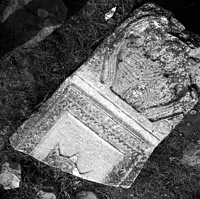
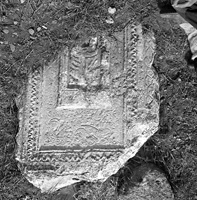

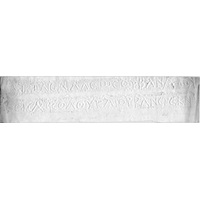
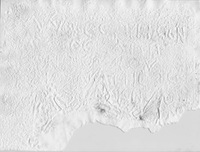
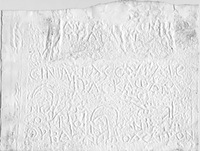



The mason of this inscription appears to have been illiterate, and it is extremely difficult to establish the relationships of the various parties. If I have interpreted the first seven lines correctly, the tomb was constructed by a certain Attas son of Dades for his wife Urbana and his step-daughter Urbana; the mother’s first husband would have been named in lines 1-2. I do not know how to interpret the two women’s names, apparently in the dative, in lines 10-12. The last three lines appear to be a curse on ‘whoever opens the tomb of Urbana’.
In 1908, Calder visited a Turkish cemetery ‘A mile and a half south of Karakilisse, in a valley running up into the Karadja Dagh’ (Calder 1910: 240). Calder claimed to have copied two inscriptions at this cemetery, ‘both of which were erected above a single Turkish grave’. He gives as the complete text of the first inscription Αττας Δαδεως Ὀρβανα[ί]ων (Calder 1910: 240, no.10; RECAM II 304), which clearly corresponds to line 1 of our text. Calder describes the second inscription as ‘A fragment of an epitaph of which only a few letters remain. One line was well preserved, consisting of the letters Ὀρβανίτει[ς]’ (Calder 1910: 240, no.11; RECAM II 305). To all appearances this ‘second inscription’ corresponds to line 2 of our text, Ὀρβανίτει[ς] being a slight misreading for the stone’s Ὀρβάν⟨η⟩ς τέκν[ῳ]. I therefore suspect that Calder’s second inscription is a phantom, resulting from careless recording of the monument in his notebook.
In both of his ‘texts’, Calder wrongly interpreted the sequence of letters ΟΡΒΑΝ- as part of an ethnic, from which he inferred a phantom Galatian village of *Orbana (perpetuated in TIB Galatien 210-11 s.v. Orbana; Barrington Atlas, Map 63 B2). In fact, we are simply dealing here with a Greek transliteration of the common Roman name Urbana: cf. e.g. TAM V 1, 168d (Saittai); I.Lampsakos 15. The name is attested in another funerary stele from Karakilise [Karacaören], MAMA XI 246 (1957/38a).